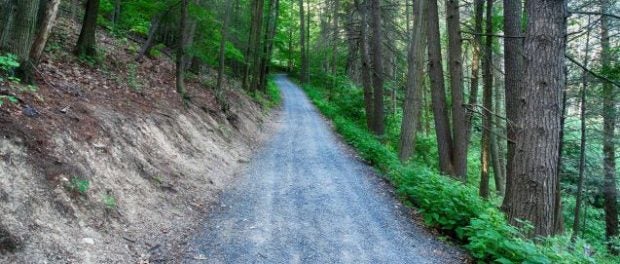Using Gravel on Farm Roads – Some Advice

To Gravel or Not, That is the Question – Using Gravel on Farm Roads
Guest post by George Lindemann of Coal Creek Farm
Good roads are a vital element of an efficiently run farm. You need to be able to go from point A to point B swiftly and without damaging equipment. But not all roads are created equal. The drive from the barn to the front entrance is essential. The road to the unused wooded area, not so much. This article will discuss the pros and cons of using gravel on farm roads, and offer advice and tips to those considering this option.
Many farms like mine are in hilly, rural areas. Our roads rarely enjoy the luxury of flat terrain. Heavy rains inevitably lead to swift water runoff, ruts, and potholes. Low lying areas can collect standing water, which eventually turns to mud. If cows run on the roads, the muddy areas get even worse. That is why gravel is an essential tool.
Correctly applied gravel gives tires traction, reducing muddy messes. But how much gravel is needed? It depends. If money were no object, I would suggest six inches of gravel on every road and trail. But this can be an expensive proposition, so it’s smarter to think through a gravel investment plan and spend wisely. The drive from the entrance to the main house could ideally use a proper six-inch gravel base where the underlying dirt is completely covered. Infrequently used roads can get by with less. Some lightly traveled trails might use a sprinkling of gravel. A 30-ton dump truck full of rock could spread the stones sparingly over several hundred feet of trail. The result would look like polka dots on a painting canvas. Loggers often use this system. Much of my Cumberland County farm was logged, and still, fifteen years later, I enjoy the sprinkled gravel on remote roads. The rocks do indeed last a long time.
A moderately used road might look like a canvas with the first coat of paint. A thin layer of rock resides on top of the dirt. Eventually, a tire will breakthrough. It’s ok if it does, this road isn’t used all that much. There is no strict rule here, rather some trial and error. You can always add more gravel later.
Finally, it’s essential to understand that rock geology is region-specific. In East Tennessee, granite quarries are plentiful. I buy a smaller cut stone (2 to 4 inches) for the moderately wet areas and more heavy-duty (4 to 6 inch) stone for perennially wet roads. I then run a bulldozer over the newly graveled area to push the rocks into the dirt. I don’t want rain runoff to wash the stones out of place. Remember, roadwork is region-specific. For example, South Florida is flat; there is no need to worry about the rock washing down a hill. Floridians wouldn’t use gravel rock because quarries don’t sell the product. They do sell a softer Lyme stone. It comes in varying sizes and works well for road base, although it might not last as long because limestone is softer than granite gravel. Reach out to the nearest quarry and ask the salesperson for help. They are in the business of road maintenance and will most likely give excellent site-specific advice regarding which type of rock and size will fit your farm’s specific needs.
The price of rock varies based on your farm location. If you live near a rock pit, you can save on the shipment. Most quarries will quote a price either delivered or picked up at the quarry. We usually pay $100 more for delivery to a choice location on our farm. The driver deposits the rock where I ask and sometimes helps me spread the stone.
The most important thing to do is to take your time and plan. Spreading gravel will maintain roads and save on equipment repair. The stones can also last a lifetime.







 Your Privacy Choices
Your Privacy Choices
Leave a comment